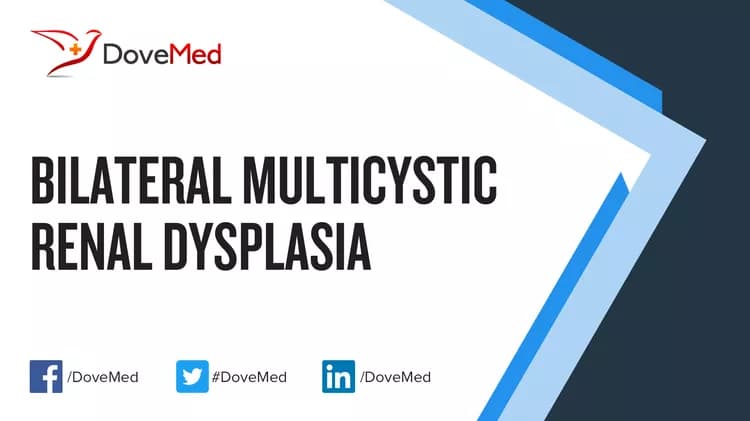What are the other Names for this Condition? (Also known as/Synonyms)
- Bilateral MRD
- Bilateral Multicystic Dysplastic Kidney
- Pelvi-Ureteric Junction Obstruction (PUJO)
What is Bilateral Multicystic Renal Dysplasia? (Definition/Background Information)
- Bilateral Multicystic Renal Dysplasia (Bilateral Multicystic Dysplastic Kidney or Bilateral MCDK)) is a lethal form of multicystic dysplastic kidney, a congenital anomaly of the kidney and urinary tract (CAKUT), in which both kidneys are large, distended by non-communicating multiple cysts and non-functional
- Bilateral MCDK may be suspected antenatally at routine ultrasound scans, with the majority detected around the 20th week of gestation. It is considered a lethal entity, and most pregnancies are terminated
- When born, such infants present with features of the Potter sequence (constellation of signs resulting from prolonged in utero oligohydramnios) including severe pulmonary hypoplasia and severe renal failure, limb anomalies, and facial dysmorphic features, and generally die shortly after birth
(Source: Bilateral multicystic dysplastic kidney; Orphanet, National Institute of Health and Medical Research (INSERM), Paris.)
Who gets Bilateral Multicystic Renal Dysplasia? (Age and Sex Distribution)
- Bilateral Multicystic Renal Dysplasia is a rare congenital disorder. The symptoms of this condition are apparent in the fetal stages or at birth
- Both males and females may be affected
- Worldwide, individuals of all racial and ethnic groups may be affected
What are the Risk Factors for Bilateral Multicystic Renal Dysplasia? (Predisposing Factors)
The risk factors for Bilateral Multicystic Dysplastic Kidney may include the following:
- A positive family history of the condition
- Use of anti-epileptic drugs by the mother during pregnancy
- Gestational diabetes in the mother
It is important to note that having a risk factor does not mean that one will get the condition. A risk factor increases one’s chances of getting a condition compared to an individual without the risk factors. Some risk factors are more important than others.
Also, not having a risk factor does not mean that an individual will not get the condition. It is always important to discuss the effect of risk factors with your healthcare provider.
What are the Causes of Bilateral Multicystic Renal Dysplasia? (Etiology)
Bilateral Multicystic Dysplastic Kidney is caused by disrupted nephrogenesis, but the exact pathogenic mechanism is still unknown.
- Disturbed formation of nephrons could result from impaired fetal urine flow early in development
- Mutations in the HNF1B gene (17q12), coding for hepatocyte nuclear transcription factor 1β, are known to cause unilateral MCDK and have only rarely been reported for bilateral cases
- MCDK is also linked to gestational diabetes and to the use of some medications during pregnancy, such as anti-epileptic drugs
(Source: Bilateral multicystic dysplastic kidney; Orphanet, National Institute of Health and Medical Research (INSERM), Paris.)
What are the Signs and Symptoms of Bilateral Multicystic Renal Dysplasia?
The signs and symptoms of Bilateral Multicystic Renal Dysplasia may include:
- Congenital megaureter
- Cystic renal dysplasia
- Flank pain
- Hydronephrosis
- Hydroureter
- Multicystic kidney dysplasia
- Nephrotic syndrome
- Renal dysplasia
- Renal insufficiency
- Renal hypoplasia
- Renal sarcoma
- Ureteropelvic junction obstruction
(Source: Bilateral Multicystic Renal Dysplasia; Genetic and Rare Diseases Information Center (GARD) of National Center for Advancing Translational Sciences (NCATS), USA.)
How is Bilateral Multicystic Renal Dysplasia Diagnosed?
Bilateral Multicystic Renal Dysplasia may be diagnosed on the basis of the following information:
- Complete physical examination
- Thorough medical history evaluation
- Assessment of signs and symptoms
- Laboratory tests
- Imaging studies
- Biopsy studies, if necessary
Ultrasound examination of a developing fetus in the 20th week of gestation may indicate Bilateral Multicystic Renal Dysplasia. Since the condition is considered lethal, an elective termination of pregnancy may be recommended.
Many clinical conditions may have similar signs and symptoms. Your healthcare provider may perform additional tests to rule out other clinical conditions to arrive at a definitive diagnosis.
What are the possible Complications of Bilateral Multicystic Renal Dysplasia?
The complications of Bilateral Multicystic Renal Dysplasia may include:
- Termination of pregnancy
- Severe pulmonary hypoplasia leading to respiratory distress
- Severe renal failure
Complications may occur with or without treatment, and in some cases, due to treatment also.
How is Bilateral Multicystic Renal Dysplasia Treated?
Bilateral Multicystic Renal Dysplasia is not a treatable condition and is generally considered lethal.
How can Bilateral Multicystic Renal Dysplasia be Prevented?
At the present time, no guidelines or methods are available for the prevention of Bilateral Multicystic Renal Dysplasia.
- If there is a family history of the condition, then genetic counseling will help assess risks, before planning for a child
- Active research is currently being performed to explore the possibilities for treatment and prevention of inherited and acquired genetic disorders
- During pregnancy, regular medical screening at periodic intervals with tests and physical examinations are highly recommended
What is the Prognosis of Bilateral Multicystic Renal Dysplasia? (Outcomes/Resolutions)
- The prognosis of Bilateral Multicystic Renal Dysplasia is poor
- If the condition is suspected in the fetus during gestation, an elective termination of pregnancy may be recommended
- If born, babies develop serious complications and are known to succumb to the condition soon after birth
Additional and Relevant Useful Information for Bilateral Multicystic Renal Dysplasia:
The following DoveMed website link is a useful resource for additional information:
Related Articles
Test Your Knowledge
Asked by users
Related Centers
Related Specialties
Related Physicians
Related Procedures
Related Resources
Join DoveHubs
and connect with fellow professionals


0 Comments
Please log in to post a comment.